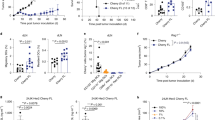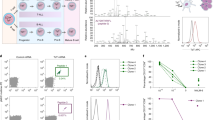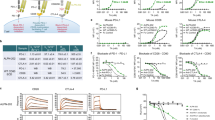Abstract
To develop gene-modified T-cell-based antileukemia adoptive immunotherapy, concomitant administration of CD4+ and CD8+ T cells that have been gene modified using identical HLA class I-restricted leukemia antigen-specific T-cell receptor (TCR) gene transfer has not yet been fully investigated. Here, using CD4+ and CD8+ T cells that had been gene modified with a retroviral vector expressing HLA-A*24:02-restricted and Wilms’ tumor 1 (WT1)-specific TCR -α/β genes and siRNAs for endogenous TCRs (WT1-siTCR/CD4+ T cells and WT1-siTCR/CD8+ T cells), we examined the utility of this strategy. WT1-siTCR/CD4+ T cells sufficiently recognized leukemia cells in an HLA class I-restricted manner and provided target-specific Th1 help for WT1-siTCR/CD8+ T cells. By using a xenografted mouse model, we found that WT1-siTCR/CD4+ T cells migrated to leukemia sites and subsequently attracted WT1-siTCR/CD8+ T cells via chemotaxis. Therapy-oriented experiments revealed effective enhancement of leukemia suppression mediated by concomitant administration of WT1-siTCR/CD4+ T cells and WT1-siTCR/CD8+ T cells. Importantly, this augmented efficacy in the presence of WT1-siTCR/CD4+ T cells was correlated with longer survival and enhanced formation of memory T cells by WT1-siTCR/CD8+ T cells. Collectively, our experimental findings strongly suggest that this strategy would be clinically advantageous for the treatment of human leukemia.
This is a preview of subscription content, access via your institution
Access options
Subscribe to this journal
Receive 12 print issues and online access
$259.00 per year
only $21.58 per issue
Buy this article
- Purchase on Springer Link
- Instant access to full article PDF
Prices may be subject to local taxes which are calculated during checkout






Similar content being viewed by others
References
Rambaldi A, Biagi E, Bonini C, Biondi A, Introna M . Cell-based strategies to manage leukemia relapse: efficacy and feasibility of immunotherapy approaches. Leukemia 2015; 29: 1–10.
Park TS, Rosenberg SA, Morgan RA . Treating cancer with genetically engineered T cells. Trends Biotechnol 2011; 29: 550–557.
Ochi T, Fujiwara H, Yasukawa M . Requisite considerations for successful adoptive immunotherapy with engineered T-lymphocytes using tumor antigen-specific T-cell receptor gene transfer. Expert Opin Biol Ther 2011; 11: 699–713.
Li Y, Moysey R, Molloy PE, Vuidepot AL, Mahon T, Baston E et al. Directed evolution of human T-cell receptors with picomolar affinities by phage display. Nat Biotechnol 2005; 23: 349–354.
Kharfan-Dabaja MA, Wierda WG, Cooper LJ . Immunotherapy for chronic lymphocytic leukemia in the era of BTK inhibitors. Leukemia 2014; 28: 507–517.
Morgan RA, Chinnasamy N, Abate-Daga D, Gros A, Robbins PF, Zheng Z et al. Cancer regression and neurological toxicity following anti-MAGE-A3 TCR gene therapy. J Immunother 2013; 36: 133–151.
Linette GP, Stadtmauer EA, Maus MV, Rapoport AP, Levine BL, Emery L et al. Cardiovascular toxicity and titin cross-reactivity of affinity-enhanced T cells in myeloma and melanoma. Blood 2013; 122: 863–871.
Davila ML, Riviere I, Wang X, Bartido S, Park J, Curran K et al. Efficacy and toxicity management of 19-28z CAR T cell therapy in B cell acute lymphoblastic leukemia. Sci Transl Med 2014; 6: 224ra25.
Antony PA, Piccirillo CA, Akpinarli A, Finkelstein SE, Speiss PJ, Surman DR et al. CD8+ T cell immunity against tumor/self-antigen is augmented by CD4+ T helper cells and hindered by naturally occurring T regulatory cells. J Immunol 2005; 174: 2591–2601.
Shedlock DJ, Shen H . Requirement for CD4 T cell help in generating functional CD8 T cell memory. Science 2003; 300: 337–339.
Kessels HW, Schepers K, van den Boom MD, Topham DJ, Schumacher TN . Generation of T cell help through a MHC class I-restricted TCR. J Immunol 2006; 177: 976–982.
Muranski P, Restifo NP . Adoptive immunotherapy of cancer using CD4+ T cells. Curr Opin Immunol 2009; 21: 200–208.
Ossendorp F, Mengede E, Camps M, Filius R, Melief CJ . Specific T helper cell requirement for optimal induction of cytotoxic T lymphocytes against major histocompatibility complex class II negative tumor. J Exp Med 1998; 187: 693–702.
Frankel TL, Burns WR, Peng PD, Yu Z, Chinnasamy D, Wargo JA et al. Both CD4 and CD8 T cells mediate equally effective in vivo tumor treatment when engineered with a highly avid TCR targeting tyrosinase. J Immunol 2010; 184: 5988–5998.
van Loenen MM, Hagedoorn RS, de Boer R, Falkenburg JH, Heemskerk MH . Extracellular domains of CD8α and CD8β subunits are sufficient for HLA class I restricted helper functions of TCR-engineering CD4+ T cells. PLoS One 2013; 8: e65212.
Xue SA, Gao L, Ahmadi M, Ghorashian S, Barros RD, Pospori C et al. Human MHC class I-restricted high avidity CD4+ T cells generated by co-transfer of TCR and CD8 mediate efficient tumor rejection in vivo. Oncoimmunology 2013; 2: e22590.
Anguille S, Van Tendeloo VF, Berneman ZN . Leukemia-associated antigens and their relevance to the immunotherapy of acute myeloid leukemia. Leukemia 2012; 26: 2186–2196.
Okamoto S, Mineno J, Ikeda H, Fujiwara H, Yasukawa M, Shiku H et al. Improved expression and reactivity of transduced tumor-specific TCRs in human lymphocytes by specific silencing of endogenous TCR. Cancer Res 2009; 69: 9003–9011.
Ochi T, Fujiwara H, Okamoto S, An J, Nagai K, Shirakata T et al. Novel adoptive T-cell immunotherapy using a WT1-specific TCR vector encoding silencers for endogenous TCRs shows marked antileukemia reactivity and safety. Blood 2011; 118: 1495–1503.
Suemori K, Fujiwara H, Ochi T, Azuma T, Yamanouchi J, Narumi H et al. Identification of an epitope derived from CML66, a novel tumor-associated antigen expressed broadly in human leukemia, recognized by human leukocyte antigen-A*2402-restricted cytotoxic T lymphocytes. Cancer Sci 2008; 99: 1414–1419.
Steimle V, Siegrist CA, Mottet A, Lisowska-Grospierre B, Mach B . Regulation of MHC class II expression by interferon-gamma mediated by the transactivator gene CIITA. Science 1994; 265: 106–109.
Miyawaki S, Emi N, Mitani K, Oyashiki K, Kitamura K, Morishita T et al. Clinical course of the disease and the level of WT1 mRNA in 191 patients with acute myeloid leukemia (AML): joint research by 23 institutions in Japan. Rinsho Ketsueki 2005; 46: 1279–1287.
Ohminami H, Yasukawa M, Fujita S . HLA class I-restricted lysis of leukemia cells by a CD8+ cytotoxic T-lymphocyte clone specific for WT1 peptide. Blood 2000; 95: 286–293.
Nagai K, Ochi T, Fujiwara H, An J, Shirakata T, Mineno J et al. Aurora kinase A-specific T-cell receptor gene transfer redirects T lymphocytes to display effective antileukemia reactivity. Blood 2012; 119: 368–376.
Ochi T, Fujiwara H, Suemori K, Azuma T, Yakushijin Y, Hato T et al. Aurora-A kinase: a novel target of cellular immunotherapy for leukemia. Blood 2009; 113: 66–74.
Asai H, Fujiwara H, An J, Ochi T, Miyazaki Y, Nagai K et al. Co-introduced functional CCR2 potentiates in vivo anti-lung cancer functionality mediated by T cells double gene-modified to express WT1-specific T-cell receptor. PLoS One 2013; 8: e56820.
Ito M, Hiramatsu H, Kobayashi K, Suzue K, Kawahata M, Hioki K et al. NOD/SCID/γcnull mouse: an excellent recipient mouse model for engraftment of human cells. Blood 2002; 100: 3175–3182.
Wetzler M, McElwain BK, Stewart CC, Blumenson L, Mortazavi A, Ford LA et al. HLA-DR antigen-negative acute myeloid leukemia. Leukemia 2003; 17: 707–715.
Tsuji T, Yasukawa M, Matsuzaki J, Ohkuri T, Chamoto K, Wakita D et al. Generation of tumor-specific, HLA class I-restricted human Th1 and Tc1 cells by cell engineering with tumor peptide-specific T-cell receptor genes. Blood 2005; 106: 470–476.
Roszkowski JJ, Lyons GE, Kast WM, Yee C, Van Besien K, Nishimura MI . Simultaneous generation of CD8+ and CD4+ melanoma-reactive T cells by retroviral-mediated transfer of a single T-cell receptor. Cancer Res 2005; 65: 1570–1576.
Legoux F, Gautreau L, Hesnard L, Leger A, Moyon M, Devilder MC et al. Characterization of the human CD4(+) T-cell repertoire specific for major histocompatibility class I-restricted antigens. Eur J Immunol 2013; 43: 3244–3253.
Ohkura N, Hamaguchi M, Morikawa H, Sugimura K, Tanaka A, Ito Y et al. T cell receptor stimulation-induced epigenetic changes and Foxp3 expression are independent and complementary events required for Treg cell development. Immunity 2012; 37: 785–799.
Colmone A, Amorim M, Pontier AL, Wang S, Jablonski E, Sipkins DA . Leukemic cells create bone marrow niches that disrupt the behavior of normal hematopoietic progenitor cells. Science 2008; 322: 1861–1865.
Castellino F, Huang AY, Altan-Bonnet G, Stoll S, Scheinecker C, Germain RN . Chemokines enhance immunity by guiding naive CD8+ T cells to sites of CD4+ T cell-dendritic cell interaction. Nature 2006; 440: 890–895.
Franciszkiewicz K, Boissonnas A, Boutet M, Combadière C, Mami-Chouaib F . Role of chemokines and chemokine receptors in shaping the effector phase of the antitumor immune response. Cancer Res 2012; 72: 6325–6332.
June C . Principles of adoptive T cell cancer therapy. J Clin Invest 2007; 117: 1204–1212.
Klebanoff CA, Gattinoni L, Palmer DC, Muranski P, Ji Y, Hinrichs CS et al. Determinants of successful CD8+ T-cell adoptive immunotherapy for large established tumors in mice. Clin Cancer Res 2011; 17: 5343–5352.
Yang S, Gattinoni L, Liu F, Ji Y, Yu Z, Restifo NP et al. In vitro generated anti-tumor T lymphocytes exhibit distinct subsets mimicking in vivo antigen-experienced cells. Cancer Immunol Immunother 2011; 60: 739–749.
Kaech SM, Tan JT, Wherry EJ, Konieczny BT, Surh CD, Ahmed R . Selective expression of the interleukin 7 receptor identifies effector CD8 T cells that give rise to long-lived memory cells. Nat Immunol 2003; 4: 1191–1198.
Gattinoni L, Lugli E, Ji Y, Pos Z, Paulos CM, Quigley MF et al. A human memory T cell subset with stem cell-like properties. Nat Med 2011; 17: 1290–1297.
Muranski P, Boni A, Antony PA, Paulos CM, Quigley MF, Almeida JR et al. Tumor-specific Th17-polarized cells eradicate large established melanoma. Blood 2008; 112: 362–373.
Acknowledgements
We thank Dr Kenji Kameda, Ehime University for technical assistance. We also thank Dr Yoshiki Akatsuka, Department of Hematology, Fujita Health University for supplying the K562-A24 and Dr Hiroo Saji, HLA Laboratory, Japan for HLA typing. This work was supported in part by grants from the Ministry of Education, Culture, Sports, Science and Technology of Japan (HF and MY); a Grant-in-Aid for Cancer Research from the Ministry of Health, Labor and Welfare (MY); a grant from Takeda Science Foundation (MY); a grant from the Uehara Memorial Foundation (MY); and a grant from the Princess Takamatsu Cancer Research Fund (MY).
Author information
Authors and Affiliations
Corresponding authors
Ethics declarations
Competing interests
SO and JM are employees of Takara Bio. All other authors declare no conflict of interest.
Additional information
Supplementary Information accompanies this paper on the Leukemia website
Supplementary information
Rights and permissions
About this article
Cite this article
Fujiwara, H., Ochi, T., Ochi, F. et al. Antileukemia multifunctionality of CD4+ T cells genetically engineered by HLA class I-restricted and WT1-specific T-cell receptor gene transfer. Leukemia 29, 2393–2401 (2015). https://doi.org/10.1038/leu.2015.155
Received:
Revised:
Accepted:
Published:
Issue Date:
DOI: https://doi.org/10.1038/leu.2015.155
This article is cited by
-
T cell receptor-engineered T cells for leukemia immunotherapy
Cancer Cell International (2019)
-
Dasatinib-induced anti-leukemia cellular immunity through a novel subset of CD57 positive helper/cytotoxic CD4 T cells in chronic myelogenous leukemia patients
International Journal of Hematology (2018)
-
Generation of higher affinity T cell receptors by antigen-driven differentiation of progenitor T cells in vitro
Nature Biotechnology (2017)



